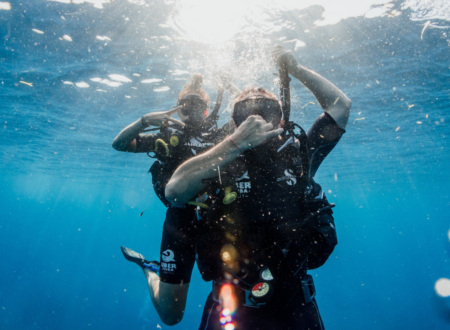Understanding the Science Beneath the Surface
Scuba diving is not only a thrilling underwater adventure but also a fascinating study in physics. By understanding the scientific principles at play, divers can appreciate the marvels of the underwater world while staying safe and comfortable throughout their dives. In this article, we will explore the physics of scuba diving, delving into buoyancy, pressure, gas laws, and the physiological effects of diving on the human body.
Buoyancy:
Archimedes’ Principle
At the core of scuba diving is the concept of buoyancy. Archimedes’ Principle states that an object submerged in a fluid experiences an upward force equal to the weight of the fluid displaced by the object. This principle helps divers understand how to achieve neutral buoyancy, which is the state of being neither positively nor negatively buoyant. By mastering buoyancy control, divers can maintain their position in the water column and minimize their impact on the environment.

Buoyancy Control Devices
Scuba divers use Buoyancy Control Devices (BCDs) to regulate their buoyancy. By adding or releasing air from the BCD, divers can adjust their buoyancy to achieve neutral, positive, or negative buoyancy as needed. This allows divers to maintain their depth, hover, or ascend and descend with ease.
Pressure
Boyle’s Law

One of the key aspects of scuba diving physics is the relationship between pressure, volume, and depth. Boyle’s Law states that the pressure of a gas is inversely proportional to its volume, provided that the temperature remains constant. As a diver descends, the increased pressure causes the volume of air in their lungs, BCD, and other air spaces to decrease. Conversely, as a diver ascends, the pressure decreases, and the volume of air expands. Understanding Boyle’s Law helps divers manage their buoyancy and avoid potential hazards, such as lung over-expansion injuries.
Dalton’s Law
Another essential gas law in scuba diving is Dalton’s Law, which states that the total pressure of a mixture of gases is equal to the sum of the partial pressures of each individual gas. In scuba diving, this law helps divers understand the effects of breathing different gas mixtures at various depths. For example, at greater depths, the increased pressure causes the partial pressure of nitrogen to rise, increasing the risk of nitrogen narcosis.
Underwater Vision
Refraction and Visibility
One of the unique aspects of scuba diving is experiencing the underwater world through a mask. However, the physics of light behaves differently underwater, which can affect a diver’s vision. When light travels from air to water, it slows down, causing it to bend, a phenomenon known as refraction. This change in light’s direction makes objects appear closer and larger than they actually are. In addition to refraction, water clarity and the presence of suspended particles can impact underwater visibility.
Colors and Light Absorption
As divers descend, they’ll notice that colors begin to fade, starting with reds and oranges and continuing through the spectrum as depth increases. This color loss occurs because water absorbs different wavelengths of light at varying rates. The longer wavelengths of red, orange, and yellow are absorbed more quickly, while shorter wavelengths, such as blue and green, penetrate deeper. To bring back some of the lost colors, divers can use artificial light sources, like dive lights, to illuminate the environment.
Gas Laws and Decompression
Henry’s Law

Henry’s Law states that the amount of a gas dissolved in a liquid is directly proportional to the partial pressure of that gas. This law is crucial for understanding decompression and the formation of nitrogen bubbles in a diver’s body. As a diver descends, the increased pressure causes more nitrogen to dissolve in their tissues. When ascending, the pressure decreases, and the dissolved nitrogen comes out of solution, forming bubbles. If a diver ascends too quickly, these bubbles can cause decompression sickness, also known as “the bends.”
Decompression Theory
Decompression theory involves the use of dive tables, algorithms, and dive computers to plan safe ascents and avoid decompression sickness. By adhering to prescribed ascent rates and performing decompression stops when necessary, divers can allow the dissolved nitrogen in their tissues to safely off-gas, reducing the risk of bubble formation and decompression sickness.
The Physics of Scuba Diving: A Foundation for Safe and Enjoyable Dives
Understanding the physics of scuba diving provides divers with a solid foundation for safe and enjoyable underwater exploration. By mastering buoyancy control, comprehending the effects of pressure and gas laws, and being aware of the physiological impacts of diving, divers can minimize risks and maximize their enjoyment of the underwater world. So, the next time you embark on a scuba diving adventure, take a moment to appreciate the fascinating science that makes it all possible.





